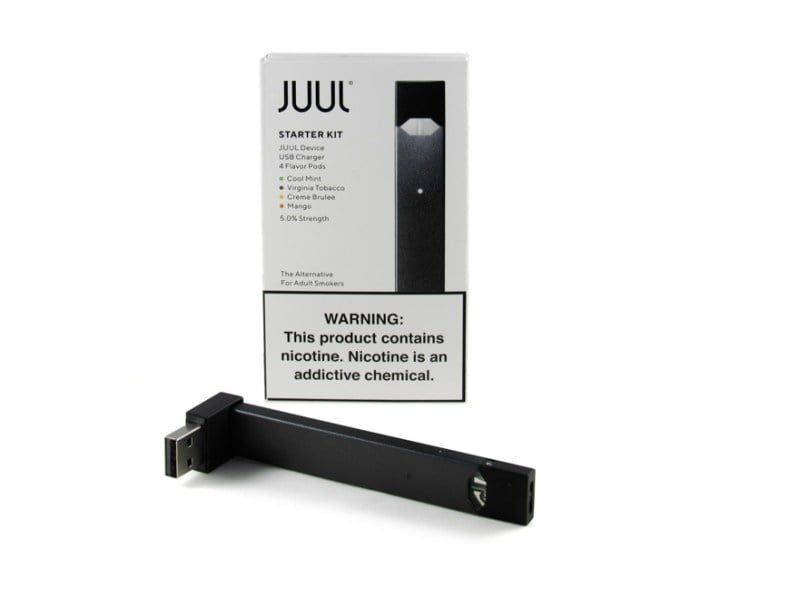JUUL co-founders described the former Stanford thesis project as a way to “take tobacco back to being a luxury good and not so much a drug delivery device” in a 2005 graduate thesis presentation, the footage of which was released by JUUL on Wednesday in a website post emphasizing the company’s mission as one to help adult smokers switch off of regular cigarettes.
The company’s post follows years of criticism for JUUL’s alleged fostering what the FDA has called an “epidemic” of youth addiction through advertisements appealing to teen audiences. The company is facing increased federal regulations as it tries to ward off underaged use of the product through its own efforts, such as the temporary removal of its flavored e-cigarettes on Nov. 13, 2018.
Laughs from fellow students and even a scene from profanity-laced cartoon series “South Park” appear in the footage of then-product design students Adam Bowen M.S. ’05 and James Monsees M.F.A. ’06 as they outline their mission and methodology in creating a new smoking alternative.
Smokers themselves, Bowen and Monsees referenced throughout their presentation what they and others saw as benefits to smoking, including elevated social status and relaxation. Still, they acknowledged the dangers of smoking, hoping to create a relatively safe product.
“Our goal was to basically create a whole new experience for people that pertains to the positive aspects of smoking, like the ritual and everything, but makes this as healthy and socially acceptable as possible,” Bowen said in the video.
Though Monsees said that, “Every cigarette is really self-destructive,” the presentation focused less on JUUL’s relative safety and more on other aspects of it that made it different than other smoking alternatives.
“Clearly there’s room for improvement in the overall experience,” Monsees said, calling tobacco “a large market” with “potential to have some real change.”
He also noted that previous products meant to provide a safer smoking experience, such as Premier and Eclipse cigarettes, Accord and Project XA, failed to meet success because they were “snuffed” by the tobacco lobby (Big Tobacco).
“There’s no design innovation going on in smoking whatsoever because Big Tobacco is really interested in not shooting themselves in their own foot — they sell cigarettes,” Monsees said.
The JUUL creators expressed hope for a final product that is “compact,” “convenient” and “environmentally benign.” They also noted their planned use of “attractive packaging” and a “variety of flavors” that they said would make the product more socially appealing.
“Adam and I were interested in working on design for social change, and we acknowledged right away that smoking was probably an easy target,” Monsees said. “There’s a lot of people who smoke who are really at odds with themselves.”
In the presentation, Bowen and Monsees showed clips of people who tested different prototypes of the eventual JUUL product. One of the testers called JUUL “the greatest thing I’ve ever encountered in my life,” while another said, “There’s a cool factor to it, and that’s a big thing I think for smoking for a lot of people, including myself.”
With regard to the product’s safety, the JUUL founders showed samples of cotton swabs tested with a standard cigarette brand, cigarette alternatives and JUUL, showing how the cotton swabs tested with JUUL are visually “indistinguishable from the pure cotton.”
“Nicotine’s addictive, clearly, but it’s not the nicotine that’s really hurting you,” Monsees said, with Bowen later noting that the two would be doing “more extensive testing, chemical and cancer testing and so forth.”
Monsees described the act of smoking in terms of absolutes, saying that the medical evidence against smoking “really puts smokers in the position of either quitting the otherwise enjoyable habit that they have or becoming a sort of hardcore smoker where they are forced to be ignorant of the side effects.”
“Where there’s smoke, there’s controversy,” he said.
In a talk focused on marketing a product, Monsees and Bowen were vague regarding their target audiences. They listed “social,” “light” and “hardcore” smokers as potential buyers but did not specify any groups they sought to avoid.
“We don’t know how our sort of experience will be received,” Bowen said, “But we hope that it will entice people along the entire spectrum.”
Contact Holden Foreman at hs4man21 ‘at’ stanford.edu.
